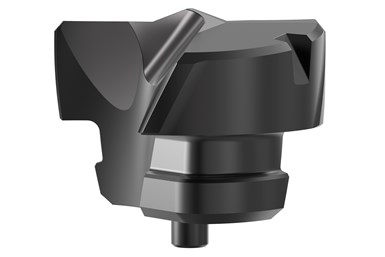Kennametal FEG Drill Insert Eliminates End Milling
Kennametal’s FEG drill insert is designed to increase the ease of drilling flat-bottom holes into difficult and curved surfaces while eliminating the need for end milling.
Share







Kennametal has expanded its replaceable drill offerings for the KenTIP FS modular drill series with the FEG insert for flat-bottom hole applications. Available for steel, cast iron and stainless steel, the insert is designed to eliminate end milling operations and complete tasks in a single operation, saving time and tooling costs.
The company has leveraged its KenTIP FS modular drill to develop its FEG insert geometry, which it says will improve drilling performance for flat-bottom holes, inclined or curved surfaces, stacked plates and casing, cross holes and rough surfaces. The insert is also said to simplify the drilling of counterbores and pilot holes.
The FEG geometry design features a 180-degree cutting edge and a conical center point, which acts as a pilot to guide the hole position and reinforce hole straightness. Corner chamfers protect the cutting edges and reduce exit burrs. Four margin lands provide stability when breaking into interrupted cuts and cross-holes. Kennametal's KCP15A grade additionally uses a nano-structured AlTiN coating and fine grain carbide substrate to provide toughness and wear resistance when drilling steel, stainless steel and cast iron. The diameter range covers between 6 and 26 mm (0.236" and 1.024"), with a drilling depth ranging to 12 × D depending on the KenTIP FS modular drill body.
Related Content
-
Lean Approach to Automated Machine Tending Delivers Quicker Paths to Success
Almost any shop can automate at least some of its production, even in low-volume, high-mix applications. The key to getting started is finding the simplest solutions that fit your requirements. It helps to work with an automation partner that understands your needs.
-
Medical Shop Performs Lights-Out Production in Five-Axes
Moving to five-axis machining enabled this shop to dramatically reduce setup time and increase lights-out capacity, but success relied on the right combination of workholding and automation.
-
How to Troubleshoot Issues With Tool Life
Diagnosing when a tool is failing is important because it sets an expectation and a benchmark for improvements. Finding out why gives us a clue for how to fix it.












